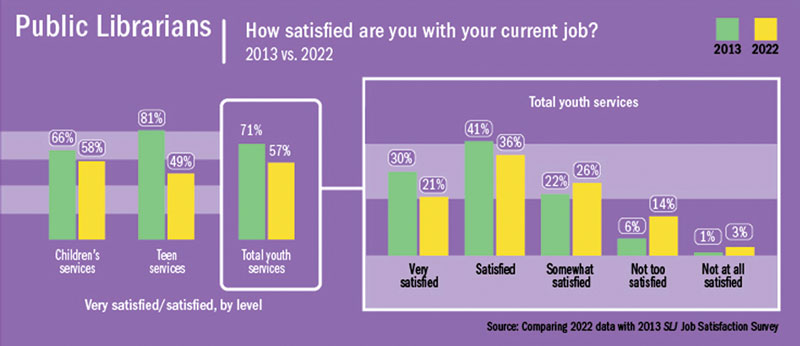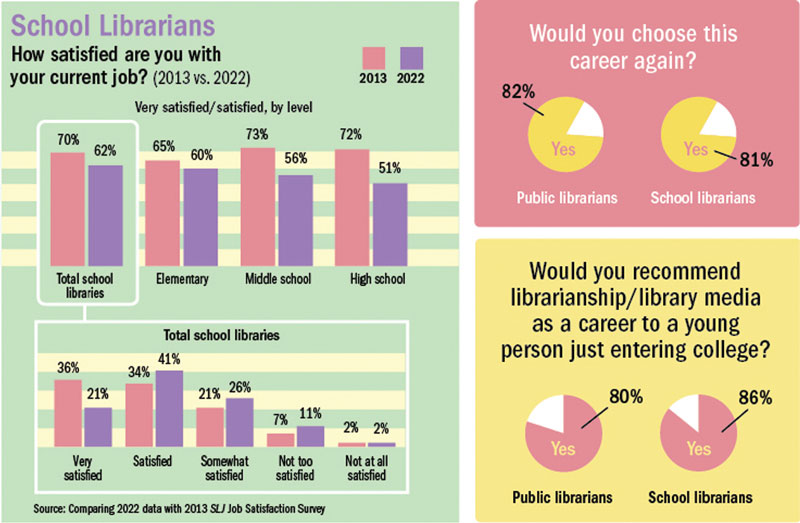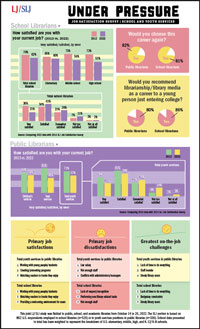Under Pressure: Survey Provides Insight into Librarians' Job Satisfaction
More librarians find their work challenging, but most still love what they do, the latest LJ/SLJ Survey shows.

School and youth services librarians are passionate about their jobs, but a lack of respect is damaging their job satisfaction and morale, according to the 2022 LJ/SLJ Job Satisfaction Survey.
That said, the respondents strongly value working with young readers. Youth services librarians at public libraries and school librarians across all grades listed “working with young people/students” as the most satisfying aspect of their job.
|
----------------- This joint LJ/SLJ study was fielded to public, school, and academic libraries from October 14 to 26, 2022. The SLJ portion is based on 862 U.S. respondents employed in school libraries (n=526) or in youth services positions in public libraries (n=336). School data presented in total has been weighted to represent the breakdown of U.S. elementary, middle, high, and K–12/K–8 schools. |
The 862 responses (from 336 youth services staff in public libraries and 526 school librarians/paralibrarians) showed a marked drop in job satisfaction. In a 2013 survey, job satisfaction was at 71 percent among respondents in public libraries and 70 percent in school libraries. This year, job satisfaction levels are at 57 and 62 percent, respectively. The largest decrease was among those working with teens in public libraries, from 81 to 49 percent.
Librarians offered several reasons, including lack of time and added work duties, lack of respect or recognition, low salaries and operating budgets, and the stress of book challenges.
The greatest shared concern was “lack of time to do everything.” School librarians worked 42.9 hours per week, the highest amount, with middle school librarians working an average of 44.6 hours. In the past year, 46 percent of youth services respondents and 23 percent of school librarians took on additional duties voluntarily, while 35 percent of youth services respondents and 30 percent of school librarians were given more responsibilities due to staff cuts.
“I am expected to manage both a middle school library (over 1,100 students) as well as textbook distribution on only 19.5 hours a week with no budget,” said Sara Lyness of Newark (CA) Junior High Library. “All book fairs, fundraisers, or grant programs to get additional books/money must be done on my own time or in the limited hours.”
“The children’s department [is] by far the library’s busiest and most popular space. It is almost unmanageable during the summer,” said youth services librarian Sara Meldrum of the Williamsburg (VA) Regional Library. “Other departments haven’t stepped up to help with my department’s workload.”
“I run five children’s programs a week and am still not able to meet all the needs and interests of the young people in this community,” wrote Celeste Bocchicchio-Chaudhri, children’s services librarian at the Roslindale branch of the Boston Public Library. “We have no full-time teen librarian, so I am trying to manage programming for birth to 18.”
“The time I spend working with students and building my collection seems like an afterthought,” said Vancouver, WA, school librarian Heather Rhone. “I spend considerable time troubleshooting digital devices, managing curriculum, etc.”
A high school librarian in Connecticut agreed. “I’m often called upon to sub when a teacher is out, provide lunch coverage, proctor tests, and manage the help desk. I constantly get pulled away from actual library work.”
Seeking more respect, money
Lack of respect or recognition was school librarians’ top concern. Sixty-six percent felt they didn’t get enough respect from their superintendents; 40 percent felt similarly about parents.
“While the kids understand what I do, the adults in my school don’t always,” wrote Clare Nolan at Bard High School Early College–Manhattan. “My colleagues who don’t work closely with me see me more as a glorified babysitter sitting in the library rather than as a professional with a master’s degree.”
District leadership likes the recognition her library receives, said Ro Menendez of Cannaday Elementary Library in Mesquite, TX. But “when they force upon me tasks limiting my time with students and unrelated to my position, it sends a message they don’t value the impact I make on students’ lives.”
Librarians also cited low pay. Among all, the average salary was highest in school libraries, nearly $69,000, and lowest in public ones, $58,000. Seventy-six percent of youth services librarians and 71 percent of school librarians felt underpaid compared to positions in other fields requiring similar education and experience.
“The money I make isn’t nearly enough to live on independently,” said Elna McIntosh at Challenger Middle School in Colorado Springs, CO. “I want to get a master’s degree but can’t afford to while working this job. There’s no budget for an additional staff member, so I work unpaid hours.”
“As a librarian with my MLIS, I think it is disrespectful that to survive as a single adult I have to sell my plasma twice a week,” wrote Amber R. Morgan-Opitz, youth services librarian at Community Library of Castle Shannon, PA, who cites inflation as a greater cause of “burnout” than COVID-19.
Budget constraints and cuts were also a concern. “Our library staff was reduced from four full-time to two in the past two years. It is impossible to do this job now and even after cutting services, it remains untenable,” said Abby Cornelius at Blue Valley North High School in Overland Park, KS.
According to Dawna Hansen-Murray at Yelm (WA) Middle School, “My budget has been the same since 1999.”

Book challenges: chilling
Others mentioned the growing problem of censorship efforts. “Book challenges…will have a chilling effect on free speech and a cost in student lives,” wrote Gavin Downing of Kentridge High School Library in Kent, WA. “The book challenge I received last year came from my principal. I’m at a new school with a new principal, but am still concerned [about] administrators being upset with me for taking a stand last year.”
“It is so frustrating that a small group of parents in our district is causing so much disruption,” wrote a Missouri high school librarian. “I don’t distribute porn. I don’t encourage students to disobey their parents. I DO work really hard to find books that appeal to ALL types of readers. I am proud of the book collection in the library.”
Several also noted a worsening in student behavior, some citing the pandemic. “We have two grades who were home during the grades [when] we really learn and reinforce proper library and classroom behavior. They are wild,” wrote Carrie Munroe of Sylvan STEAM Academy in Modesto, CA.
Still, they love the job
Despite the challenges, many respondents love their work. “Finding that one book that makes a nonreader into a reader or having the exact book a child wants is so emotionally satisfying—it makes me feel like a superhero!” said Mara Alpert, a children’s services librarian at Los Angeles Public Library.
“Almost every school I know about has some level of dysfunction right now,” said Rochelle Garfinkel of Northampton (MA) High School. “But I enjoy my job because of the teens/students I get to see every day.”
Logan Adams, youth services librarian at Lincoln County Public Library in Stanford, KY, said, “To watch the little ones in my story times develop and reach milestones, and to do the same with my teens is fascinating….I’m making a difference in my home community, and I wouldn’t trade for anything.”
“My greatest joy is interacting with young people,” wrote Kimberly Kelley Johnson, of Vestavia Hills (AL) High School. “I love talking to them, helping them find books they love, and teaching skills to help them evolve into lifelong learners.”

A second career
Seventy-eight percent of school librarians came to librarianship as a second career (mostly from teaching) and never regretted it. In fact, 81 percent would choose librarianship again. But only 36 percent of school librarians would enthusiastically recommend the field; 49 percent would with reservations.
Comments reflected that mixed view. “I love being a librarian and highly recommend it; however, I would share about the lower pay and current trend of book challenges,” wrote a North Carolina high school librarian.
Respondents named things they wished they’d learned in library school, including more tech skills, how to lead social justice discussions, responding to book challenges, and having difficult conversations with administrators. Several noted the importance of book repair skills and hands-on experience.
“I firmly believe that children’s librarians need to receive some sort of performance/theatrical training to serve as better entertainers and educators when programming,” said Becca Worthington, children’s services librarian at ImaginOn/Charlotte Mecklenburg Library in Charlotte, NC.
There was a lot of advice for new grads, including: Be flexible and open to new things. Join library associations and social media groups. Working in public education has become more difficult, some noted, suggesting private schools instead.
Joyce Souva, YA/teen services librarian at Toledo (OH) Lucas County Public Library, said, “I have many young people saying they’d like to enter librarianship someday. I tell them it can be difficult to get into and not to make it the first choice.”
Many still offered an upbeat take on the industry. “The library is a place for innovation, ideas, and initiative, spanning all academic subjects, and requires thoughtful collaboration with faculty,” said Elodie Sutton Domenge of Rochambeau, French International School in Bethesda, MD. “It’s a place to get kids interested in reading, writing, creating, technology, and it is never boring!”
Marlaina Cockcroft is a writer and editor with a passion for children’s books.
RELATED
The job outlook in 2030: Librarians will be in demand
The job outlook in 2030: Librarians will be in demand
ALREADY A SUBSCRIBER? LOG IN
We are currently offering this content for free. Sign up now to activate your personal profile, where you can save articles for future viewing








Add Comment :-
Be the first reader to comment.
Comment Policy:
Comment should not be empty !!!